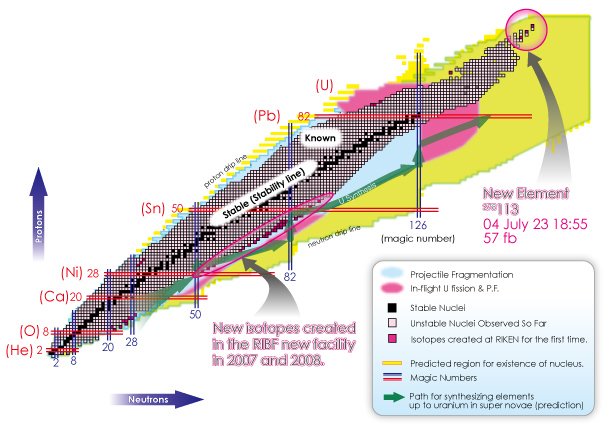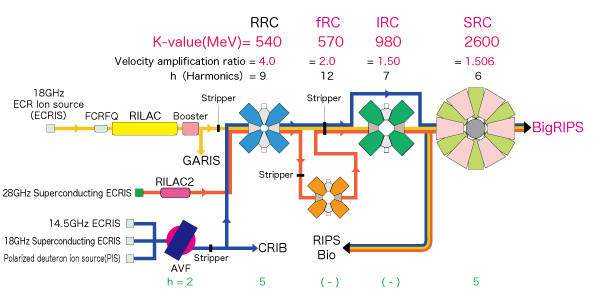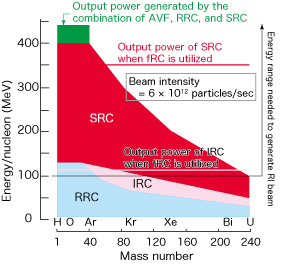What is the RIBF?
The Radioactive Isotope Beam Factory (RIBF) is a facility generating unstable nuclei of all elements up to uranium and studying their properties.
The RIBF is characterized by the fact that it is a multistage accelerator complex, which is generally not seen elsewhere in the world. The final-stage accelerator, the Superconducting Ring Cyclotron (SRC), is the first of a kind and is the largest (weighing 8,300 tons) and most powerful in the world.
Three ring cyclotrons: a fixed-frequency Ring Cyclotron (fRC), an intermediate-stage Ring Cyclotron (IRC), and a superconducting Ring Cyclotron (SRC) are utilized in an integrated way, along with a superconducting radioactive isotope beam separator (BigRIPS). This drastically improves the RI beam’s generating capability, thereby providing an RI beam for all elements up to uranium with the highest intensity in the world. Moreover, the RIBF aims to utilize the RI beam produced toward high-degree applications in a wide range of fields using various types of innovative experimental apparatus (some are in preparation). This will not only enable us to pursue fundamental research, such as establishing new nuclear models or elucidating the origin of the elements, but also to contribute to creating new industries using innovative RI technologies.
All facilities including accelerators and experimental devices are placed underground.
A drastic expansion of the view of the nuclear world using SRC and BigRIPS
Current hypothesis of uranium synthesis postulates that nuclei with the green arrows (see a figure below) were synthesized at once in a supernova explosion, and subsequently decayed to create heavy elements up to uranium via β-decays; however, all of these elements remain undiscovered. The RIBF can produce nuclei in the light-blue area (produced in nuclear spallation reactions of injected nuclei provided by a stable nucleus beam) and pink area (produced in nuclear fission reactions induced by the uranium beam), which would allow us to verify this hypothesis in the laboratory for the first time in the world. This, in turn, means that almost all nuclei that are being created and have been created in the universe will become accessible in the laboratory.

This figure depicts a table of nuclides. Each cell represents a single nucleus type; the number of constituent protons and neutrons for each nucleus type are shown in vertical and horizontal lines, respectively. Black cells indicate naturally-occurring stable nuclei and the remainder have been created experimentally. In 2002, a new RI 43Si, which was close to the creation limit of the facility of that time, was discovered. The current hypothesis of uranium synthesis postulates that nuclei with the green arrows (see the figure below) were synthesized at once in a supernova explosion, which subsequently decayed to create heavy elements up to uranium via β-decays; however, all of these elements remain undiscovered. The RIBF can produce nuclei in light-blue and pink areas, which would allow us to verify this hypothesis in a laboratory for the first time in the world.
Formation of an accelerator complex to generate RI beam

To accelerate uranium up to 345 MeV per nucleon, the fRC located between the RIKEN Ring Cyclotron (RRC) and IRC is utilized. This integration can produce the world’s most powerful heavy ion beam at 80 kW. Moreover, to accelerate polarized deuteron up to 440 MeV per nucleon, the Azimuthally Varying Field Cyclotron (AVF) is used as an injector, which is integrated into the RRC and SRC (without the fRC and IRC).
Target energy and intensity for which the RIBF aims
 The right figure shows beam type and energy that the RRC and each of the fRC, IRC, and SRC can produce. Higher intensity and energy provided by the RIBF can drastically increase the types and intensity of the resulting RI beam, enabling researchers to conduct experiments that have been thought impossible due to low intensity or energy and a wide variety of experiments that utilize new types of RI beam.
The right figure shows beam type and energy that the RRC and each of the fRC, IRC, and SRC can produce. Higher intensity and energy provided by the RIBF can drastically increase the types and intensity of the resulting RI beam, enabling researchers to conduct experiments that have been thought impossible due to low intensity or energy and a wide variety of experiments that utilize new types of RI beam.




